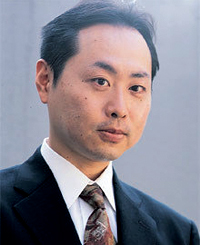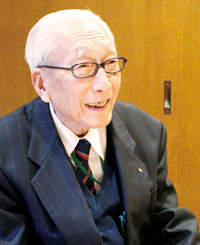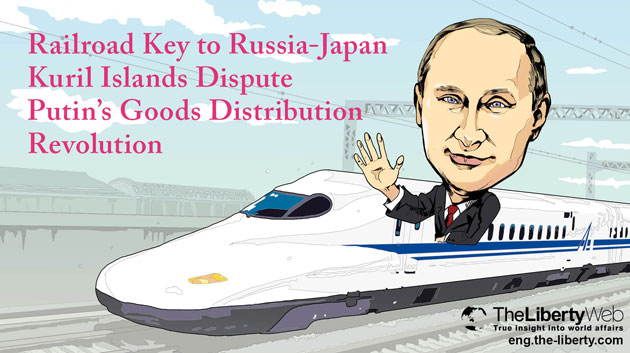Railroad Key to Russia-Japan Kuril Islands Dispute
Putin's Goods Distribution Revolution
The public expects a resolution to the Kuril Islands dispute with President Putin’s visit to Japan, but the Russian leader has a greater plan in mind.
The absence of a peace treaty between Russia and Japan is not stopping them from approaching each other warmly in recent years. Vladimir Putin, Russia and Japan have held a total of 11 talks since his presidential inauguration in 2012. One of these talks led to the suggestion of Putin’s visit to Japan, and after much postponement due to the Crimea problem, it was finally settled that Putin will visit the hometown of Japanese Prime Minister Shinzo Abe in Yamaguchi prefecture.
Japan anticipates a closure to the long pending issue of the Kuril Islands, but Putin is cautious. “We resolved territorial issues with China after 40 years of negotiations,” he said in a September interview. “We’re not yet at this stage with Japan.”
Russia and Japan at Cross-Purposes
Japan isn’t just wanting their island back either. In May, Japan proposed economic cooperation on 8 issues including expanding businesses into the Far East, and promoting medical science and industrialization. To show their sincerity, they even invited the Minister of the Development of the Russian Far East in September.
Russia responded in October by requesting support on 68 issues, the central items being importing Russian farm products and energy development in the Far East. It also included politically connected items such as constructing a new pipeline between Sakhalin and Japan, and the development of the Crimea area.
Much of the reaction in the Japanese media was pessimistic: “constructing a cross-border pipeline is a fantasy”; “Russia is trying to find a compromise for the territorial negotiation of the Kuril Islands.”
But what is important now is to try to see what Russia is thinking.
Column: What is the Kuril Islands Territorial Dispute?
Here is a background summary of the Kuril Island dispute:
Territorial negotiations go back to the late 19th century. In 1875, Russia and Japan signed the Treaty of Saint Petersburg agreeing that Sakhalin Island would belong to Russia and the Kuril Islands would become Japanese territory. After Japan’s victory in the Russo-Japanese War, the Treaty of Portsmouth negotiations in 1905 ended with the south of Sakhalin Island being handed over to Japan.
The Misunderstanding
The current Kuril Islands dispute arose out of a misunderstanding in post-war 1945.
At the time there was a non-aggression pact between Japan and the USSR, but on 9 August 1945, the USSR invaded the Kuril Islands. From the Japanese perspective, Russia suddenly broke the pact without warning. From the Russian perspective, the Yalta Conference held in February 1945 with the U.S. and U.K., gave them justification to attack. Japan regained the Kuril Islands and South Sakhlin Island in the 1951 Treaty of Peace with Japan, but this did not include the South Kuril Islands.
The people of Russia see the matter in sundry ways: some think that the Islands are unmistakably Russian territory, while others are not even aware that such a dispute is going on.
The basis of the current Kuril Islands dispute stems back to the Soviet-Japanese Joint Declaration of 1956, a peace treaty signed to return territorial rights of Shikotan, the Habomai Islands to Japan. They came to this conclusion during talks between the Japanese Prime Minister and President Putin in 2001, while serving his first term.
Around 17,000 Russians live in the Northern Territories of the Kuril Islands. It is maintained through Russian infrastructure management, houses Russian military facilities, and is considered an important military position being an ice-free port facing the Pacific Ocean.
Interview 1
Yoshinori Kitano
International relations analyst living in Russia, Yoshinori Kitano, provided us with insight into how Russia sees the dispute.

Yoshinori Kitano
Born in Nagano prefecture in 1970, he studied international relations at Moscow State Institute of International Relations. He served as advisor to the President of Buryat Autonomous Soviet Socialist Republic and founded the email magazine “Journal of Russian Politicals and Economics”. His book publications include “The Kremlin Method You Never Knew About”.
For Russia, losing the two islands in dispute is a big deal. The reason why they still want to negotiate is because they want to advanced economic cooperation with Japan.
In Russian history, territorial rights have been redevised after every war, but Russia was originally just the Kievan Rus’ which is now the capital of Ukraine. This is why they don’t quite grasp the meaning when Japan asks for the Kuril Islands to be returned: for Russia, it is unfair for a war-defeated country to demand the return of their territory.
With the Kuril Islands, however, negotiations are based on the Soviet-Japanese Joint Declaration of 1956, so it is possible to have the islands returned depending on the conclusion reached by our leaders. It will be a matter of balancing between Russia, who wants to leave the matter with 2 islands each, and Japan who cannot back off until all are returned.
Russia “Has No Choice But to Choose . . . China”
The thing we need to be most wary of is a situation where Russia has no choice but to choose to ally with China. If Japan has to face both China and Russia, they will surely be defeated if a war breaks out near the Senkaku Islands.
Russia is generally pro-Japan/anti-China, and they are fearful of Eastern Siberia being taken over by China. For Russia, it was a big relief when China clearly showed they were on the Russian side when they were isolated after the annexation of Crimea. Japan, on the other hand, helped with the sanctioning of Russia. Consequently Russian government authorities would most likely chose China over Japan should the occasion arise.
In November 2012, China proposed to Russia a mutual anti-Japan war front. It was a plan to force Japan to give up territorial demands and add the U.S. to the mutual front.
When I learned of this, I realized that China would one day declare war on Japan. It has already begun its preliminary stages: information warfare.
Japan’s top priority should be to separate China and Russia, and protect the Senkaku and Okinawan Islands. For this, Japan should agree to economic cooperation with Russia and improve Russia-Japan relations. The Kuril Islands may or may not return as a result, but in a tense situation like this it is not an urgent matter.
All Roads Lead to Moscow
The Russian Dream and Railway Revolution
While the world spotlight is glaring at the Kuril Islands dispute, Russia has something further in mind.
With Putin’s planned visit, a proposal was made to construct a bridge or tunnel across the Strait of Tartary or La Perouse, and extend the Trans-Siberian railway to Hokkaido in Japan.
“It will fill the Trans-Siberian railway cargos with Japanese goods”, Putin said back in 2011; and he has not changed his mind.
Japanese, Russian and Central European Goods Circulation Canal
The Trans-Siberian railway is the longest railway in the world, spanning 9000km between Moscow and Vladivostok in the Far East. After his reelection in 2012, Putin reiterated the need to modernize the Trans-Siberian railway to accommodate the amount of transport which has increased ten-fold since 1988.
The Putin administration established the Ministry for Development of the Far East of Russia reflecting its high priority for the government. At a 2013 conference in Yuzhno-Sakhalinsk the Ministry discussed the potential for creating a goods circulation canal between Japan, Russia and Central Europe, and came to a decision to extend the railway to Hokkaido.
Russia dreams of a colossal economic bloc connected via a railway network that traverses the world, including North America. It was possibly Russia’s economic problem that gave rise to this idea: crude oil prices heavily affect the economy because industrialization is stagnant and they are solely dependent on resource exportation.
One policy solution for this is the creation of a good circulation network. It would make things much more efficient if the current container ship import/export relations between Russia and Japan are converted to railway transportation. It would encourage businesses to enter the other country, and it would advance Russia’s industrialization.
Putin wants a better worldwide circulation revolution to stabilize the Russian economy so they can share the future with other countries.
Interview2
Eichi Yamaguchi
President of the Committee for the Internationalization of the Trans-Siberian Railway

Eichi Yamaguchi
Born in 1929 in Tokyo, he graduated from Keio University with a degree in economics. He later served in the Japanese Ministry of Justice, Hitachi High-Technologies and Ford Motor Company, and now works as an international development consultant. His publications include “Russia’s Serious Far East Strategy”.
The Abe administration is trying to resolve the Kuril Islands dispute and sign a peace treaty. But Putin’s visit doesn’t just mean the islands will be returned immediately. Japan wants ‘the islands’ and Russia wants ‘money’ for development. It is difficult to come to a mutually meritorious decision while maintaining their national honor and trying not to misinterpret the other party’s intensions.
China has continued to provide aid to Siberia since the China-Russia territorial issues were resolved. This sort of support should really be taken up by Japan, and Russia wants that too.
A Change in Goods Circulation
Russia has a poor industrial network, so they want to focus on railway construction to connect China, Europe and the U.S. This is how they came up with the idea of bridging the Strait of Tartary or La Perouse. The plan was first made public in 2004 when a Russian railway authority entered investment negotiations with the U.S. It also appeared in the 100th anniversary magazine for the Russian railway.
Some people criticize that no one will use the route, but what is more important is freight transportation. The area around Siberia and the Far East that lies along the railway is a treasure-trove of natural resources. And while trucks can only carry several tons per vehicle, the railway could carry 6000 tons in one go. It gives rise to the possibility for Japan to join the Siberian resource development. And the faster more effective transportation would change the flow of goods between Europe and Japan.
Serious Railway Developments in Other Countries
In 1997, when I did a presentation on my ‘21st Century dream’ ideals of connecting Moscow and Tokyo via railway, I got an invitation from the chairman of the Irkutsk city assembly, and was invited to their 1999 forum.
Due to the Kuril Islands dispute I had to speak as a civilian from the Committee of the Internationalization of the Trans-Siberian Railway, but nonetheless important people from the Russian and American governments attended the forum.
When there was a Europe-Eurasia railway conference in St. Petersburg in 2000, I was the only Japanese attendee amongst many Korean and Chinese government ministers. China is advancing their “One Belt One Road” plan to connect Europe and Asia, and countries such as China, America and Russia are very serious about these plans. If Japan doesn’t do anything, we’ll be left behind. Japan needs to have a wider perspective view in entering future negotiations with Russia.
A Bullet Train to Connect Russia and Japan
Extending the Trans-Siberian railway to Hokkaido is no far-fetched dream.
It will cost an estimated US$13.5 billion to connect Russia and Sakhalin across the Strait of Tartary (7.3km at the narrowest point), and then to Japan across the La Perouse Strait (42km at the narrowest point).
The Seikan tunnel, which is 53 km in length, cost US$7 billion when it was made. The 15 km Tokyo bay Aqua-Line bridge-tunnel, and the world’s longest suspension bridge, Akashi Kaikyo Bridge cost around US$14 billion. Estimating from this, the Russia-Japan project is not impossible.
Eichi Yamaguchi remarked that “the world is going beyond the Kuril Islands dispute: we need a much bigger plan. ”
The Russia-Japan Dream
Towards the beginning of the 20th Century, Japan had planned an underwater train line from Tokyo to Beijing as part of the Asian independence and co-prosperity ideals of the Greater East Asia Co-Prosperity Sphere. They had another railway route planned across Central Asia to Berlin along the Silk Road. The latter idea became too difficult after WWII, but it is still possible to create a grand economic region thanks to Japan’s bullet train technology, connecting Japan to Europe via Russia and even to the U.S. Thus connected, the exchange of people, goods, money and information will become much more active.
Introducing the bullet train to Siberia and the Far East would make it much easier to export the wealth of resources lying in the area. Hokkaido could also become a gateway for freight exchange.
Japan should counter Russia’s goods circulation revolution idea for an even bigger one, because it is high time that Russia and Japan cooperate in the name of progress. Economic cooperation and strengthening of relations is the quicker path to resolving the Kuril Islands dispute.



















